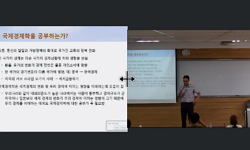본 연구의 목적은 우리나라의 지역경제 성장이 지역간 교역 및 미세먼지 배출에 미치는 영향을 분석 하는 것이다. 중력모형을 기반으로 한 2단계최소자승법으로 지역경제 성장과 지역간 교...
http://chineseinput.net/에서 pinyin(병음)방식으로 중국어를 변환할 수 있습니다.
변환된 중국어를 복사하여 사용하시면 됩니다.
- 中文 을 입력하시려면 zhongwen을 입력하시고 space를누르시면됩니다.
- 北京 을 입력하시려면 beijing을 입력하시고 space를 누르시면 됩니다.

지역경제 성장이 지역간 교역과 체화된 미세먼지 배출에 미치는 영향 = Impact of Regional Economic Growth on Regional Trade and Particulate Matter Emissions Embodied in Trade
한글로보기https://www.riss.kr/link?id=A107303393
- 저자
- 발행기관
- 학술지명
- 권호사항
-
발행연도
2021
-
작성언어
-
- 주제어
-
KDC
320
-
등재정보
KCI등재
-
자료형태
학술저널
-
수록면
255-276(22쪽)
-
KCI 피인용횟수
1
- 제공처
- 소장기관
-
0
상세조회 -
0
다운로드
부가정보
국문 초록 (Abstract)
본 연구의 목적은 우리나라의 지역경제 성장이 지역간 교역 및 미세먼지 배출에 미치는 영향을 분석 하는 것이다. 중력모형을 기반으로 한 2단계최소자승법으로 지역경제 성장과 지역간 교역량 및 체화 된 미세먼지량의 관계를 추정하고 분석하였다. 분석한 결과, 지역간 교역량과 체화된 미세먼지량은 이출지역과 이입지역의 산출량에 비례하였다. 체화된 미세먼지 배출량이 이입지역의 산출량에 비례하는 것은 생산지역뿐만 아니라 소비지역도 미세먼지 배출에 책임이 있음을 보여준다. 또한, 최종재에서 교역량과 미세먼지 배출의 거리탄력성이 더 컸다. 이는 중간재에 체화된 미세먼지의 배출은 거리보다 산업의 집적, 에너지 소비구조와 같이 다른 요인의 영향을 더 많이 받음을 의미한다. 마지막으로, 지역별 경제성장 시나리오를 바탕으로 미세먼지 배출 증가율이 교역량 증가율보다 큰 지역과 작은 지역이 구분되었다. 이 결과는 미세먼지 배출이 경제성장뿐만 아니라 지역의 산업적 특성에 따라 달라짐을 의미한다. 본 연구의 결과는 미세먼지 저감정책을 시행할 때, 정부가 미세먼지 배출에 관한 특성을 고려해야 함을 시사한다.
다국어 초록 (Multilingual Abstract)
The purpose of this study is to analyze relationships between regional trade and Particulate Matter (PM2.5) emission in South Korea. Trading volume and embodied PM between trading regions is estimated by two stage least square method based on gravity ...
The purpose of this study is to analyze relationships between regional trade and Particulate Matter (PM2.5) emission in South Korea. Trading volume and embodied PM between trading regions is estimated by two stage least square method based on gravity model. The result shows that trading volume and embodied PM2.5 is proportional to output of the exporting region and the importing region. The increased PM2.5 emissions as output increases in the importing region increases indicates that not only the exporting region but also the importing region is responsible for PM2.5 emissions. Also, distance elasticity of embodied PM2.5 and trading volume of final goods is larger than that of intermediate goods. In terms of PM2.5, Embodied PM2.5 in intermediate goods is more affected by other factors, such as industrial agglomeration and energy consumption rather than distance. Finally, according to different regional economic growth scenarios, it is found that PM2.5 growth rate in some regions is higher (or lower) than the trading volume growth rate. It implies that the increase in PM2.5 emissions depend on regional industrial characteristics as well as regional economic growth. These findings indicate that when implementing PM2.5 emission reduction policies, it is necessary for the government to consider the characteristics of PM2.5 emissions in various regions.
참고문헌 (Reference)
1 황석준, "환경규제와 오염피난처 가설*- 우리나라 제조업을 중심으로" 한국경제통상학회 25 (25): 91-110, 2007
2 지해명, "지역간 교역의 추정: 지역경제 성장에 관한 추론" 한국경제학회 57 (57): 135-163, 2009
3 박건영, "중력모형과 한국의 지역 간 교역규모" 한국관세학회 16 (16): 231-247, 2015
4 김의준, "미세먼지의 지역별 생산기반 배출량과 소비기반 배출량" 한국지역개발학회 31 (31): 101-122, 2019
5 현대경제연구원, "미세먼지에 대한 국민 인식 조사" (833) : 2019
6 환경부, "미세먼지 관리 종합대책" 2017
7 대한민국 정부, "미세먼지 관리 종합계획 2020~2024" 2019
8 환경부, "동북아 장거리이동 대기오염물질 공동연구 보고서 최초발간"
9 Ishise, H., "Trade in Polarized America: The Border Effect between Read States and Blue States" 55 (55): 1647-1670, 2015
10 OECD, "The Economic Consequences of Outdoor Air Pollution" OECD Publishing 2016
1 황석준, "환경규제와 오염피난처 가설*- 우리나라 제조업을 중심으로" 한국경제통상학회 25 (25): 91-110, 2007
2 지해명, "지역간 교역의 추정: 지역경제 성장에 관한 추론" 한국경제학회 57 (57): 135-163, 2009
3 박건영, "중력모형과 한국의 지역 간 교역규모" 한국관세학회 16 (16): 231-247, 2015
4 김의준, "미세먼지의 지역별 생산기반 배출량과 소비기반 배출량" 한국지역개발학회 31 (31): 101-122, 2019
5 현대경제연구원, "미세먼지에 대한 국민 인식 조사" (833) : 2019
6 환경부, "미세먼지 관리 종합대책" 2017
7 대한민국 정부, "미세먼지 관리 종합계획 2020~2024" 2019
8 환경부, "동북아 장거리이동 대기오염물질 공동연구 보고서 최초발간"
9 Ishise, H., "Trade in Polarized America: The Border Effect between Read States and Blue States" 55 (55): 1647-1670, 2015
10 OECD, "The Economic Consequences of Outdoor Air Pollution" OECD Publishing 2016
11 Wood, R., "Structual Decomposition Analysis of Australia’s Greenhouse Gas Emissions" 37 : 4943-4948, 2009
12 Takahashi, K., "Production-based emissions, consumption-based emissions and consumption-based health impacts of PM2. 5carbonaceous aerosols in Asia" 97 : 406-415, 2014
13 Hossain, M. S., "Panel Estimation for CO2 Emissions, Energy Consumption, Economic Growth, Trade Openness and Urbanization of Newly Industrialized Countries" 39 : 6991-6999, 2011
14 Su. B., "Input-output and Structural Decomposition Analysis of Singapore’s Carbon Emissions" 105 : 484-492, 2017
15 OECD, "How's Life? 2020: Measuring Well-being" OECD Publishing 2020
16 Chan, F., "Gravity models of trade: unobserved heterogeneity and endogeneity" NYU 2014
17 Peters, G. P., "From production-based to cunsumption-based national emissions inventories" 65 (65): 13-23, 2008
18 Duarte, R., "Factors Driving Embodied Carbon in International Trade:A Multiregional Input-output Gravity Model" 30 (30): 545-566, 2018
19 Huo, H., "Examining air pollution in China using production and consumption -based emissions accounting approaches" 48 (48): 14139-14147, 2014
20 Zheng, H., "Examing Determinants of CO2 Emissions in 73 Cities in China" 8 : 2016
21 Al-mulali, U., "Econometric Analysis of Trade, Exports, Imports, Energy Consumption and Co2 Emission in Six Regions" 33 : 484-498, 2014
22 Davis, S. J., "Consumption-based accounting of CO2 Emissions" 107 (107): 5687-5692, 2010
23 Wang, S., "Carbon Emissions Embodied in China-Australia Trade:A Scenario Analysis based on input-output Analysis and Panel Regression Models" 220 : 721-731, 2019
24 Du, H., "CO2 Emissions Embodied in Chin a-US trade: In put-output An alysis Based on the Emergy/dollar Ratio" 39 : 5980-5987, 2011
25 국립환경과학원, "2013 국가 대기오염물질 배출량"
26 한국은행, "2010년 및 2013년 지역산업연관표"
동일학술지(권/호) 다른 논문
-
- 한국경제통상학회
- 10
- 2021
- KCI등재
-
- 한국경제통상학회
- 김인배(Inbae Kim)
- 2021
- KCI등재
-
글로벌 금융위기 전후의 통화정책과 거시경제변수 간의 구조적 관계 비교
- 한국경제통상학회
- 박준서(Junseo Park)
- 2021
- KCI등재
-
도시공간구조 변화 연관성 분석 : 대 특⋅광역시를 중심으로
- 한국경제통상학회
- 정경숙(Jung, Kyeong Sook)
- 2021
- KCI등재
분석정보
인용정보 인용지수 설명보기
학술지 이력
| 연월일 | 이력구분 | 이력상세 | 등재구분 |
|---|---|---|---|
| 2026 | 평가예정 | 재인증평가 신청대상 (재인증) | |
| 2020-01-01 | 평가 | 등재학술지 유지 (재인증) |  |
| 2017-01-01 | 평가 | 등재학술지 유지 (계속평가) |  |
| 2013-01-01 | 평가 | 등재학술지 유지 (등재유지) |  |
| 2010-01-01 | 평가 | 등재학술지 유지 (등재유지) |  |
| 2008-01-01 | 평가 | 등재학술지 유지 (등재유지) |  |
| 2005-08-25 | 학회명변경 | 한글명 : 한국국민경제학회 -> 한국경제통상학회영문명 : The Korean National Economic Association -> The Korean Economic and Business Association |  |
| 2005-01-01 | 평가 | 등재학술지 선정 (등재후보2차) |  |
| 2004-01-01 | 평가 | 등재후보 1차 PASS (등재후보1차) |  |
| 2002-07-01 | 평가 | 등재후보학술지 선정 (신규평가) |  |
학술지 인용정보
| 기준연도 | WOS-KCI 통합IF(2년) | KCIF(2년) | KCIF(3년) |
|---|---|---|---|
| 2016 | 0 | 0.46 | 0.58 |
| KCIF(4년) | KCIF(5년) | 중심성지수(3년) | 즉시성지수 |
| 0.54 | 0.53 | 0.924 | 0.17 |





 KCI
KCI 스콜라
스콜라





